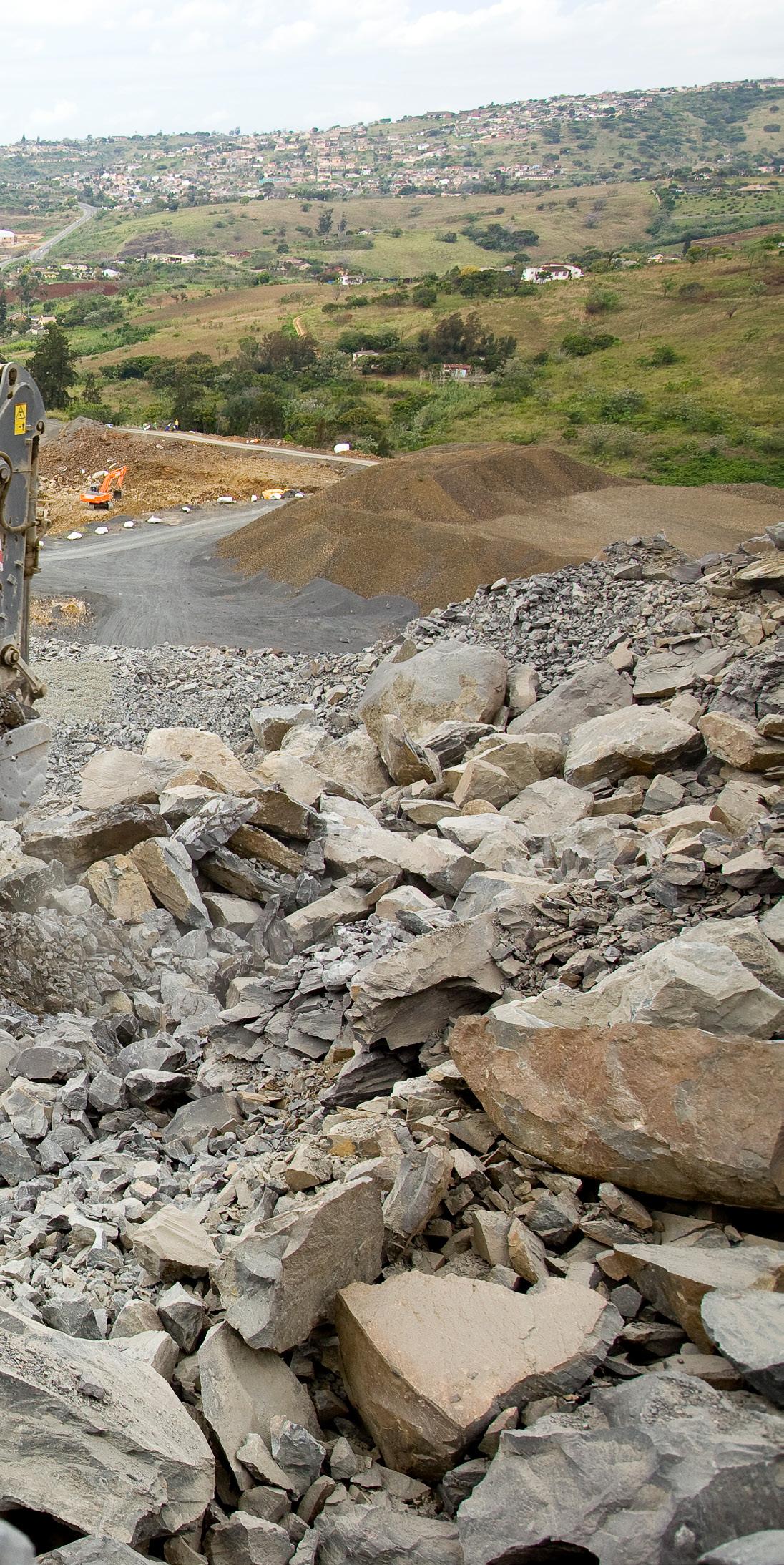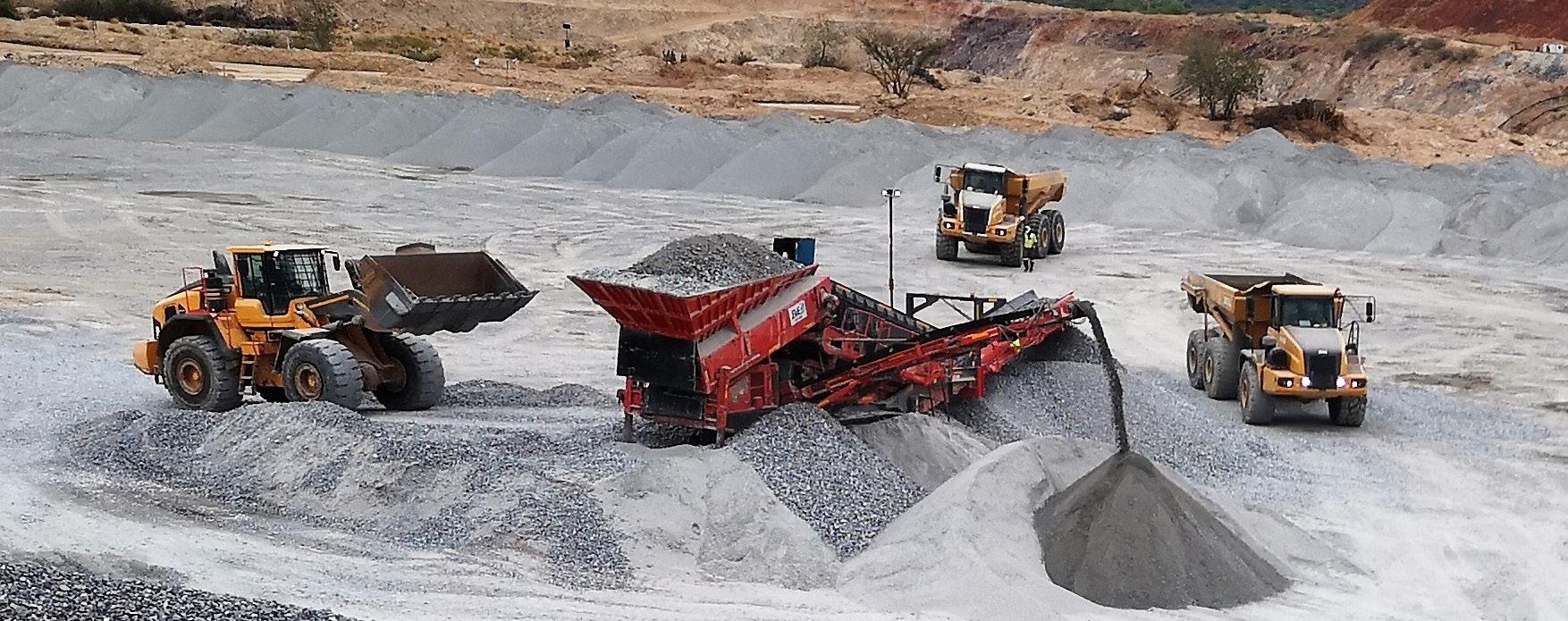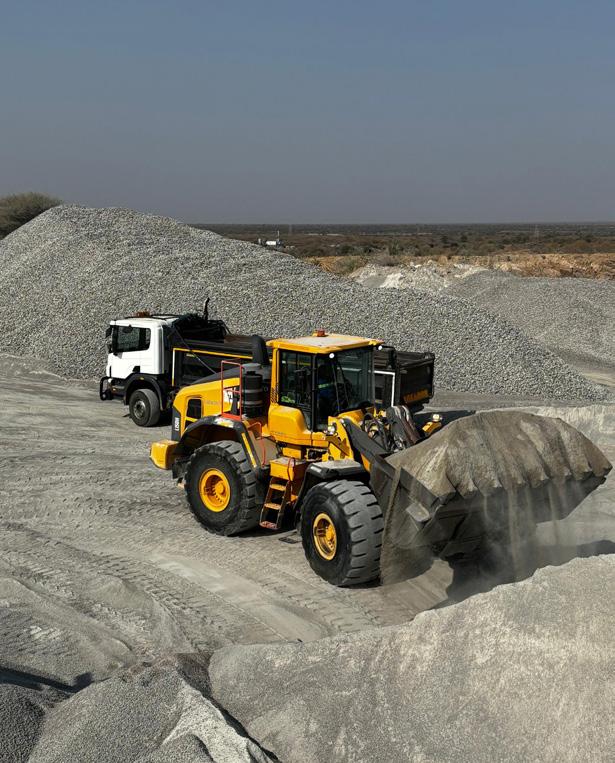
STRIVING FOR SUSTAINED GROWTH









Striving for sustained growth in the face of ongoing adversity, South Africa’s small surface mining and quarrying sector is calling for more accessible legislation with a view to bolstering emerging business
Writer: Lily Sawyer | Project Manager: Deane Anderton

Due to its abundance of natural resources, well-established mining infrastructure, and longstanding status as a key exporter of metals and minerals, the South African mining industry continues to thrive.
Historically, the majority of its output has been attributed to larger mines, often controlled by multinational conglomerates. Today, however, small surface mines and quarries are also playing a growing role.
Supported by mining legislation from the Department of Mineral Petroleum Resources (DMPR), small surface mining involves employing mechanised and semi-mechanised technologies to reach small deposits of mineral ore available at shallow depths.
South African quarrying, meanwhile, leverages the region’s natural stone resources and significant clay deposits to extract stone, clay, sand, and aggregates essential to the country’s construction and manufacturing sectors and is a major contributor to the economy.
Both small surface mining and quarrying have been identified as important areas of development by DMPR for their contributions to socioeconomic growth, job creation, and poverty alleviation.
In addition, the promotion of safe, legal quarrying and mineral exploration that pays heed to the relevant health, safety, and environment (HSE) practices, alongside taxations and royalties, has become an important focus for key industry players.
However, challenges have arisen as the very real threat of illegal mining in South Africa (SA) looms, in which derelict and ownerless (D&O) mines and quarries, often with extremely dangerous conditions, are being exploited through non-approved methods.
Illegal miners are also selling their product at very low prices due to the absence of compliance measures, regulation, and taxation, which can lead to legal small and artisanal mining companies struggling to compete.
As such, SA’s small surface mining and quarrying industry is shrinking, compounded by high regulatory and legislative barriers, which have led to industry bodies such as ASPASA, the Institute of Quarrying Southern Africa (IQSA), and DMPR working to actively reverse this.
Less restrictive and more accessible legislation surrounding small surface mining and quarrying is therefore being called for, allowing new entrants, including micro, small, and medium-sized enterprises (MSMEs), to flourish.
We sit down with Letisha van den Berg, Director of the surface mining industry association, ASPASA –formerly known as the Aggregate and Sand Producers Association of Southern Africa – who outlines the organisation’s crucial role in advocating for SA’s small surface mining and quarrying industry, its close partnership with IQSA, and their united goal to promote and develop the sector

Africa Outlook (AO): Firstly, please could you introduce us to ASPASA?
Letisha van den Berg, Director (LvdB):
ASPASA is a non-profit organisation that advocates for the small surface mining industry. We work alongside various industry bodies and government agencies to influence leading practices, develop standards, and shape legislation that aligns with the unique needs of small surface mines.
The organisation actively liaises with industry bodies such as IQSA, DMRE, the Minerals Council of South Africa (MINCOSA), the Mine Health and Safety Council (MHSC), the South African Diamond Producers Organisation (SADPO), the South African National Roads Agency SOC Limited (SANRAL), the Southern African Bitumen Association (Sabita), and Construction Alliance South Africa (CASA) to promote the interests of our members. We use our collective voice to ensure that the concerns and requirements of small surface mines are considered when drafting and implementing regulations and standards.
One of ASPASA’s key roles is to provide guidance on environmental and safety protocols, permit requirements, and training programmes. We help our members navigate the complex legislative landscape by offering clear and practical advice on compliance requirements. This ensures that small surface mines can operate safely, responsibly, and in full compliance with regulations.
ASPASA also plays a vital role in reducing the risk of accidents and environmental harm within the industry. We conduct audit processes to assess the compliance
VISION
• To promote a healthy and sustainable small surface mining industry in SA, positively impacting the economy and those affected by the immediate mining context
MISSION
• To represent the interests and be the voice for small opencast mining companies in SA, especially MSMEs
• Act as a forum for its members
• Establish its miners as suppliers of choice based on stringent compliance, regulation, and leading practices
• Drive the zero-harm journey
and safety practices of our members, identifying areas for improvement and providing actionable recommendations. The association also serves as a networking platform for small surface mines and the broader supply chain. By bringing together various stakeholders, ASPASA facilitates collaboration, knowledge sharing, and business opportunities. This helps small surface mines to connect with suppliers, contractors, and other industry professionals, fostering relationships that can contribute to the growth and success of their operations.
Furthermore, ASPASA is dedicated to developing young industry members in association with IQSA. We provide training programmes and opportunities for professional development, empowering new and emerging leaders in the small surface mining industry. Through mentorship and knowledge sharing, ASPASA helps shape the future of the industry by nurturing a skilled and knowledgeable workforce.
“WE WORK CLOSELY WITH IQSA, WHERE THE FOCUS IS ON NETWORKING AND INDIVIDUAL DEVELOPMENT PROGRAMMES”
– LETISHA VAN DEN BERG, DIRECTOR, ASPASA
AO: What is your take on the current challenges and opportunities facing the South African surface mining and quarrying sector?
LvdB: Challenges:
• Artisanal and small mining is currently shrinking, particularly when it comes to industrial minerals suppliers. We have direct connections with the construction industry, but there are currently no large projects or enough infrastructure spending in any region to boost industrial minerals supply.
• Legislation is moving rapidly towards technology, yet artisanal and small mining resources remain very limited. We do not have, for example, software developers on hand to repair technologies if they go wrong.
• The enforcement of the current Mine Health and Safety Act talks about significant risk and emphasises a risk-based approach, yet this is failing us as small role players. A blanket enforcement strategy in certain regions is costing us a lot of money due to the unnecessary closure of mines.

B&E International is the industry leader and partner of choice to Africa’s mining and construction industries, offering premium products and integrated crushing, mining, and mineral solutions
B&E International’s (B&E) enviable position is made possible through its continued culture of excellence and the establishment of long-term relations with clients and suppliers, resulting in acceptable returns to stakeholders and cutting-edge integrated crushing, mining, and mineral solutions.
The company’s initial core business centred around aggregate production supply for infrastructure projects, but over the years, it has branched into many other disciplines, such as bulk mining, mineral beneficiation, and engineering.
B&E forms part of the listed company, Raubex Group Limited (Raubex), which holds several subsidiaries that are leaders in their respective fields, namely road construction and rehabilitation, infrastructure development, pipelines, concrete structures, and the supply of materials.
B&E has grown to be operational across Southern Africa with contractors in 13 of the continent’s countries.


B&E was founded in South Africa in 1972 as a drilling and blasting entity, expanding into mobile crushing four years later, whereby a specialist mobile and static crushing division was created, which later became B&E.
The company then grew from strength to strength and entered the mining services sector in 1993, diversifying into bulk mining, the processing and beneficiation of minerals, design and construction of purpose-built plants, as well as the maintenance and operation of processing plants for mine owners and operators.
It also entered the asphalt and processing plants market through the acquisition of Comar Plant Design and Manufacturing.
B&E was acquired by Raubex in 2008 and through further rationalisation, the company is now a strong and focused crushing,
mining, mineral processing, and engineering entity.
B&E operates as an industry leader in this field with an impressive portfolio of clients including De Beers, NAMDEB, Anglo American Platinum, Gautrain, BHP, Grinaker LTA, Group Five, WBHO, Government Department of Water and Sanitation, Basil Read, Roshcon, H&I Construction, AfriSam, Exxaro, and many more.



B&E boasts four comprehensive operational divisions, covering areas of contract crushing and screening, quarry and mining services, mineral processing and engineering, and commercial aggregates. The vast extraction of valuable minerals starts with the efficacy of B&E’s crushing and screening procedure. The company operates several crushing plants, ranging from single stage to five-stage crushing, with operational capacities spanning 50 to 500 tonnes per hour (t/h).

B&E additionally offers reliable and efficient quarry and mining services. Its operational prowess and expertise in these areas allows clients to easily achieve their goals. Indeed, the company’s open cast mining services include stripping, mine and quarry rehabilitation, load and haul services, stemming material supplies, and primary and secondary breaking, resulting in production efficiency and long-term profitability.
B&E also owns and operates an
entire drill and blast division that focuses on drill and blast activities in both the quarrying and mining industries.
Through its mineral processing and engineering division, meanwhile, the company provides state-ofthe-art commercial mining infrastructure and set-up, with various engineering and monetary options to suit its clients’ requirements.
This includes the set-up of a greenfields mining operations from scratch, alongside the rehabilitation of existing projects.
In addition, B&E’s commercial aggregates division means the company can produce and supply choice aggregates from three of its conveniently located quarries across Southern Africa.
B&E’s crushing and screening division in particular has been key to the company’s industryleading position.

This is, in part, due to the vast infrastructure involved in B&E’s contract quarrying and aggregate production. The creation of railway ballasts, for example, involves S1 and S2 ballast specification material that uses mobile and static crushing plants.
The company’s aggregate production also supplies road layer works and roadstone materials, as well as being used for dam building, where high specification concrete aggregates are available from B&E’s mobile or static crushing plants.




The company’s aggregate production infrastructure is additionally used in marine works and the high-quality supply of armouring, core, rip rap, sea defence, and all other aggregates involved in marine construction.
Elsewhere, B&E’s world-class screening capabilities also enable the separation of particles into different sizes. This is achieved using a fleet of modern crushers ranging from 50 to 500 t/h.
These crushers can produce a wide range of high-quality products including roadstone, top-grade manufactured concrete sand, base course, concrete aggregates, waterbound macadams, ballasts, and filter media.
As such, the company’s expertise lies in designing mobile plants, prospecting for rock, and operating quarries to deliver consistency at high production rates, even in remote areas.
B&E’s mobile crushing capabilities
further include high energy blast efficiency and optimal fragmentation with on-site crushed blast hole stemming materials and equipment.
Additionally, the company conducts haul road maintenance by leveraging world-class on-site crushed road wearing course material critical for existing haul road maintenance.
B&E also provides clients with safe and professional dump tailings retreatment services across various mining commodity sectors.
As part of its multidisciplinary expertise, B&E boasts extensive experience in crushing and processing ore minerals including gold, iron ore, manganese, detrital, chrome, quartz, nickel, kimberlite, and coal to name a few.
The company’s vast crushing equipment fleet is available at a

moment’s notice and convenient for short-term interventions typically required during planned shutdowns, equipment breakdowns, plant upgrades, or mining start-ups.
Long-term crushing solutions are provided through B&E’s costeffective modular-based crushing plants that run on a three-phase power supply.

These installations are fit-forpurpose and are typically suited for longer-duration crushing contracts.
On top of this, the company can be trusted to blend ore correctly with its professional supply and operation of ore blending equipment and processes on-site.
B&E also ensures efficient metallurgical plant performance by using a combination of crushing, screening, and material handling equipment in conjunction with its extensive process design capabilities.

B&E has a vast range of innovative services, including its build, operate, own, and transfer (BOOT) contracts.
The company owns an extensive greenfield mineral processing plant which it uses as part of its BOOT contracts. The plant is designed, manufactured, installed, financed, and operated on behalf of the client.
This offers a multitude of benefits, including the fact that there is no need for the client to secure financing, and that fixed production costs are charged at the commencement of the contract.
Additionally, B&E carries all production and operational related risks, whilst process plants are designed to be fit for purpose, ensuring maximised reliability and production.
Moreover, BOOT contract periods typically constitute at least three to five years. Upon completion of the initial contract period, ownership of the plant shifts to the client.
Elsewhere, B&E has committed to improving its environmental and social practices for nearly a decade to help boost the capabilities of its offerings.
This is reflected by the reconsideration of its everyday activities and its commitment to social and eco-conscious daily activities.
This is demonstrated by the company’s integrated sustainability model, which aligns with key industry standards such as bluesign® System, the ZDHC Gateway, alongside Registration, Evaluation, Authorisation, and Restriction of Chemicals (REACH), and many more.
Such commitments offer a clear path for the company to follow, achieving innovation in a socially and environmentally responsible way.
B&E boasts a vast range of flagship operations, however, one particular project that stands out is the design, manufacture,

and installation of a turnkey sand crushing, screening, and washing plant at Raumix’s Rossway Quarry in Midrand, South Africa. Raumix has a long and proud history in the aggregate market with experienced engineering and technical support at its disposal, and B&E will be onboard to assist its customers whenever possible.
The capital equipment for the Rossway Quarry project was procured by B&E from its suppliers, with who it collaborated to refine the design and layout according to its client’s requirements.
Through collaboration between B&E, Raumix, and its suppliers, the company provided Raumix with a 230 t/h sand plant capable of producing approximately fivemillimetre (mm) washed sand. This will significantly benefit central Gauteng’s construction industry where sand resources are becoming scarce.
The project was first contracted in April 2024, with installation commencing four months later.
Following the warranty period, B&E will continue to provide support for the plant as and when it is needed. B&E’s leading engineering team is responsible for the installation and commissioning of the plant, which consists of a 32 by 44-inch jaw crusher supported by three gyro cones of various sizes, feeding into a washing plant that includes a 12-metre diameter thickener and two washing units. This setup enables the client to
produce high spec washed sand in sizes ranging from five to 10mm, and up to a total of 2,550 tonnes per day, depending on shift arrangements.
The inclusion of a large thickener also enhances water recovery to over 70 percent, which was a crucial factor in the project’s feasibility. Additionally, the plant consists of two radial stackers, which further enhance customer satisfaction.
B&E takes pride in being part of this project and looks forward to serving the industry.
Please feel free to contact B&E for your plant and engineering needs, offering a comprehensive range of support and maintenance services tailored to not only the aggregate industry but the mining industry also.
+27 (11) 966 4300
info@beinternational.co.za
www.beinternational.co.za

• Encroaching communities around our mines are also a challenge as there is currently no governmental protection in place from the DMRE Building plans are often approved within a 100 to 500-metre radius of the mines, which poses issues when it comes to dust, noise, and blasting processes. Yet, industrial mineral suppliers will continue to operate in urban areas due to the benefits presented by a smaller delivery radius. As such, we need to find common ground between quarries, communities, and government institutions.
• Illegal sand and aggregate miners selling their product at extremely low costs compared to legal entities have presented an issue, alongside the construction mafia disrupting operations through individual beneficiation demands.
Opportunities:
• Artisanal and small mining can open up opportunities in new areas. The delivery circle of aggregate supply is small, therefore, new mining rights and permits can assist in expanding the industry, meaning we can make an impact on SA’s overall economy.
• Small mines contribute positively to the development of communities they operate in, particularly in terms of employment, training, and job creation. Small MSME projects also uplift communities, promoting sustainable small businesses.
AO: What strategies does ASPASA deploy to assist companies’ growth in new markets?
LvdB: Last year, we had a conference related to quarrying in the year 2050, designed to sensitise industries to what’s to come and the benefits of innovative and sustainable solutions. IQSA and ASPASA also work together to
promote the same message on the future of mining, alongside developing a young workforce.
We also promote MINCOSA’s Mining Industry
Occupational Safety and Health (MOSH) initiatives and encourage mines to participate in industry research projects. We also participate in case studies relating to the benefits of innovative mines.
Elsewhere, ASPASA encourages participation in MHSC’s regional tripartite forums where leading practices are shared and the association can influence the drafting of codes of practices and legislation. ASPASA also aligned its 2025 health and safety strategy to MHSC milestones to ensure we drive the zero-harm journey.
“OUR AIM IS TO ASSIST ALL SMALL ROLE PLAYERS IN THE MINING INDUSTRY, EXPAND COMMUNITY MEMBERSHIP, AND INCREASE OUR GOVERNMENTAL LIAISONS”
– LETISHA VAN DEN BERG, DIRECTOR, ASPASA
AO: As a non-profit organisation, how does ASPASA engage with the government and ensure that members’ voices are heard at a local, regional, and national level?
LvdB: We meet with DMPR regional representatives to discuss the sector on a national level. The platforms were created to engage and influence legislation in a tripartism format, which includes employers, organised labour, and the state.
ASPASA also sits on the MHSC board that represents employers of small mines to engage on further legislation.






We also have regional meetings to glean industry insights and determine areas of focus.
Our HSE audits, through which members’ HSE compliance is assessed and commended, are an example of how we ensure their voices are heard. We also advise on challenges members might face with water use licences, social and labour plans (SLPs), mining rights and permits, and blasting approvals, to name a few. This also assists us in engaging meaningfully with government.
AO: How does ASPASA encourage training and skills development amongst its members?
LvdB: We work closely with IQSA, where the focus is on networking and individual development programmes. We forge career paths for various positions in the small surface mining space, linking competency training accordingly.
We work with the Mining Qualifications Authority (MQA) and offer recognition of prior learning (RPL) training, as well university routes.
ASPASA is building a relationship with MQA in order to stay informed about the upcoming Quality Council for Trades and Occupations (QCTO) process that will be starting soon. Our annual audits give us an overview of operational and specialised skills that may require development, such as occupational medical practitioners, occupational hygienists, rock engineers, and government certificate of competency (GCC) engineers.

We encourage mines to consider internships and bursaries through their SLPs and internal development programmes. This can also be seen as an opportunity for training and development, as auditors often share leading practices and legal requirements in the form of practical examples.
AO: Looking ahead, how do you see the industry developing over the next five to 10 years?
LvdB: The junior, small, and artisanal mining industry voice is growing rapidly, and I foresee it leading the way and influencing legislation positively, alongside contributing significantly to the SA economy.
Elsewhere, we will move into rare earth mining and supplying processing plants for the renewable energy drive.
Also on the horizon, I see recycled material being managed optimally, synergies with other companies to optimise waste management, and combined community projects for increased impact.
Illegal mining, meanwhile, may experience legal framework adjustments through the Artisanal Small-Scale Mining (ASM) policy.
AO: With this in mind, what are ASPASA’s key future priorities in order to continue representing the interests of its members across the industry?
LvdB: We have already expanded from our former status as Aggregate and Sand Producers Association of Southern Africa to ASPASA, a small surface mining association.

ASPASA’s role as the small surface mining industry’s representative body is closely linked with IQSA, which represents quarrying professionals. As such, collaboration between the two is essential to promote and sustain the industry in SA.
Since van den Berg was appointed Director of ASPASA in 2023, she has worked closely with Jeremy HunterSmith, Chairman of IQSA, to grow and develop the collaboration.
Today, the two organisations proudly work together to offer training, skills development, and continued professional development (CPD) to key industry players and emerging professionals. In this way, they seek to close industry skills gaps in an ever-changing business and operational environment.
As part of their efforts, the IQ Academy Select virtual training programme, which was introduced by ASPASA and has since been promoted by both organisations, encourages young membership and offers the opportunity to interact and engage with leading original equipment manufacturers (OEMs).
Going forwards, developing and growing young industry members remains a priority for both organisations, whilst HSE and socioeconomic advancement are also key targets.
Our aim is to assist all small role players in the mining industry, expand community membership, and increase our governmental liaisons.
We will also continue to carry out focused case studies to strengthen our voice, promote sustainable mining by creating synergies, and combine mine projects to benefit surrounding communities.
Tel: +27 (011) 791-3327
office@aspasa.co.za
www.aspasa.co.za

Tel: +27 (011) 791-3327 office@aspasa.co.za www.aspasa.co.za
